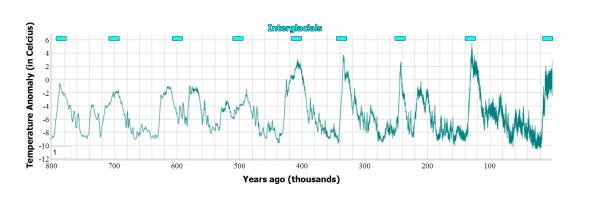Weather Versus Climate
Aren't Weather and Climate the Same?
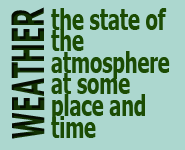 People often confuse weather and climate; they are not identical. According to the American Meteorological Society (AMS), weather is defined as the state of the atmosphere at some place and time, usually expressed in terms of temperature, air pressure, humidity, wind speed and direction, precipitation and cloudiness. Meteorologists study the atmosphere, processes that cause weather and the life cycle of weather systems.
People often confuse weather and climate; they are not identical. According to the American Meteorological Society (AMS), weather is defined as the state of the atmosphere at some place and time, usually expressed in terms of temperature, air pressure, humidity, wind speed and direction, precipitation and cloudiness. Meteorologists study the atmosphere, processes that cause weather and the life cycle of weather systems.
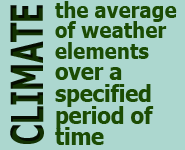
Climate is defined in terms of the average (mean) of weather elements (such as temperature and precipitation) over a specified period of time. (The World Meteorological Organization defines the typical time period as 30 years.) Climate also encompasses weather extremes for a particular place. Scientists have developed a variety of ways for classifying climate. In the early 20th century, a German scientist named Wladimir Köppen developed one of the most widely used classification systems. The Köppen Climate Classification System categorizes climate into five main types, which can be further divided into subcategories. The table below shows the five main climate types and characteristics of each type.
Summary of Köppen's Climate Classification System
| Type of Climate | Characteristics |
|---|---|
| Tropical | Humid and average temperature above 18°C (64°F) |
| Dry | Evaporation exceeding precipitation with constant water deficiency throughout the year |
| Moderate | Humid and warm or hot summers and mild winters with average temperatures between -3°C (27°F) and 18°C (64°F) |
| Continental | Humid and warm summers with the average temperature of warmest month exceeding 10°C (50°F) cold winters with average temperature of coldest month below -3°C (27°F) |
| Polar | Extremely cold winters and average temperature of the warmest summer month below 10°C (50°F) |
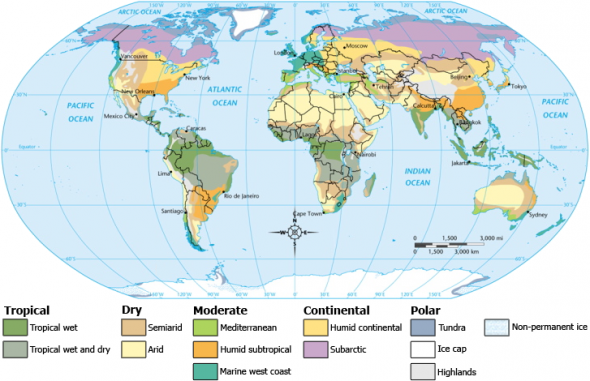
Map of Global Climate Classifications.
Image Source:
Wikipedia
The planet's climate has actually changed many times over Earth's long geologic history. For example, over the past million years, Earth has experienced several major ice ages interspersed with interglacial (warmer) periods. The relatively constant and favorable interglacial period of climate experienced over the past 8,000 years has made human civilization's advancement possible.
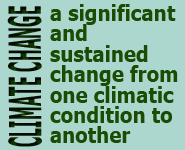 Climate change refers to a significant and sustained (over decades or longer) change from one climatic condition to another.
The term
“global warming”
refers to a specific kind of climate change in which Earth's average temperature is increasing.
Of growing concern is what is known as
Climate change refers to a significant and sustained (over decades or longer) change from one climatic condition to another.
The term
“global warming”
refers to a specific kind of climate change in which Earth's average temperature is increasing.
Of growing concern is what is known as 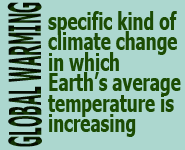 abrupt climate change. According to the National Oceanic and Atmospheric Administration (NOAA),abrupt climate change is a relatively new area of scientific research whose formal definition is still being developed, but refers to a sudden, rapid change from one climate state to another (over a period of years rather than centuries or millennia).
abrupt climate change. According to the National Oceanic and Atmospheric Administration (NOAA),abrupt climate change is a relatively new area of scientific research whose formal definition is still being developed, but refers to a sudden, rapid change from one climate state to another (over a period of years rather than centuries or millennia).
What Is Abrupt Climate Change?
The U.S. Climate Change Science Program defines abrupt climate change as “a change in the climate (for example, in temperature or precipitation) that takes place over a few decades or less, persists for at least a few decades, and causes substantial disruptions in human and natural systems.” Abrupt climate change may affect the entire globe or just a region.
Forecasting Weather Versus Climate
Meteorologists focus primarily on real-time (current) data to predict local or regional atmospheric conditions for the hours, days or weeks ahead. Thus, weather prediction tends to be more local and relates to conditions in the immediate future from days to weeks.
Climate scientists, on the other hand, look at atmospheric conditions in terms of averages and trends (patterns) that have occurred over many decades, centuries, and millennia. Weather is variable, but can be averaged over time to indicate climate trends. Therefore, climate scientists can use weather data plus proxy data to help them identify previous trends to improve their predictions of future trends.
 Image Source:
NASA
Image Source:
NASA
Meteorologists and climate scientists use similar tools. Weather balloons, satellites, specially designed airplanes, and radar and other ground-based data collection instruments (to measure wind speed, precipitation, air temperature, humidity levels, etc.) are all good examples. These methods and tools have enabled humans to collect reliable atmospheric data on a consistent basis since the mid 1800s. They have grown increasingly more precise and sophisticated over time, to such an extent that meteorologists can now consistently provide reasonably accurate near-term (1 week or less) weather forecasts.
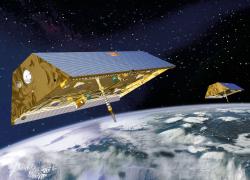 Image Source:
NASA
Image Source:
NASA
Climate monitoring requires data covering a much longer time period and over all areas of the planet. Sophisticated Earth-observing satellites equipped with remote-sensing equipment circle the globe. With each pass, they can record sea surface and other temperatures, measure atmospheric gases and rainfall amounts, take visible and infrared photos of Earth's surface, and calculate Earth's outgoing infrared and reflected solar radiation.
Increasing Resolution of Global Climate Models
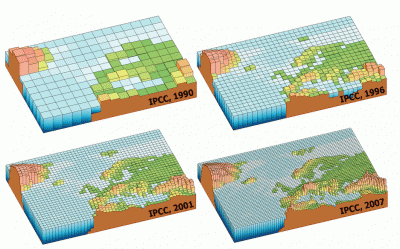 Increasing Resolution of Global Climate Models.
Image Source:
IPCC
Increasing Resolution of Global Climate Models.
Image Source:
IPCC
Climate scientists also use increasingly higher resolution computer models, known as global climate models, to simulate the physical processes of the atmosphere and oceans and make predictions about future climate scenarios.

